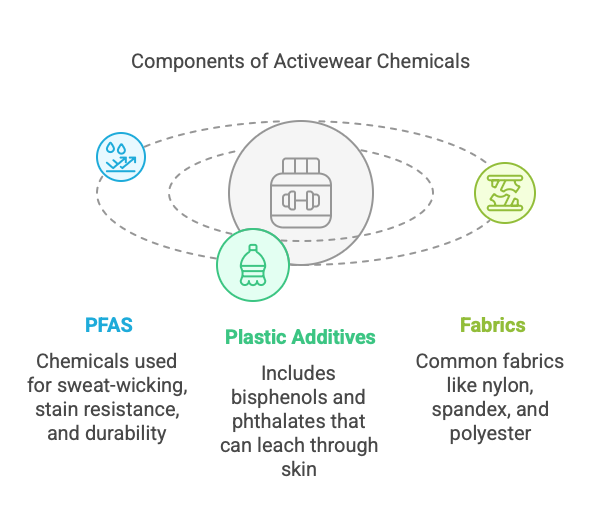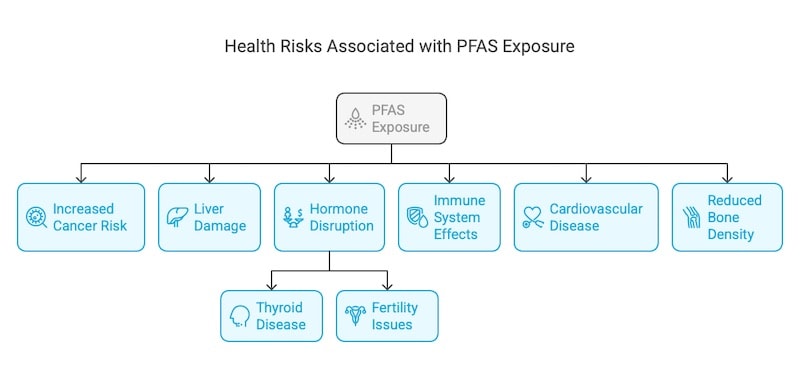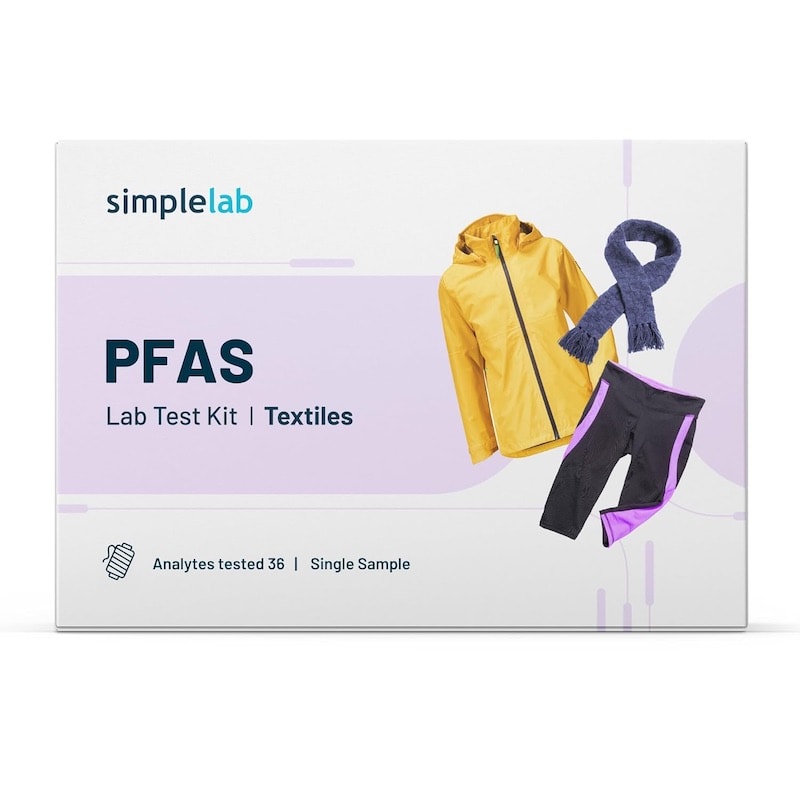Table of Contents
PFAS in Workout Clothes: Is Your Activewear Toxic?
This page may contain affiliate links. We may earn a commission on purchases, at no additional cost to you. Learn more →
Did you know that 25% of tested activewear including popular brands like Lululemon and Old Navy contained detectable levels of "forever chemicals" ? Our deep dive uncovers the hidden risks of PFAS in Workout Clothes, revealing how these “forever chemicals” could impact your health and the environment.
PFAS (Per- and polyfluoroalkyl substances) or "forever chemicals" are synthetic chemicals that are widely used in products due to their 'water-resistant' properties. However, PFAS are of particular concern as they can accumulate in the environment and in our bodies, causing long-term health risks like hormone disruption and even cancer!
I came across a study that found PFAS in 1 in 4 workout clothes tested - including Lululemon leggings and Athleta shorts. What's worse? Sweating in these leggings increases chemical absorption into our skin!
Before you panic, in this article’ll walk you through why PFAS are used in activewear, the big risks they pose, and the practical steps you can take to protect yourself.

What Are PFAS? Understanding the "Forever Chemicals"
PFAS refers to a giant family of around 15,000 human-made chemicals, prized for water- and stain-resistance. They’re nicknamed “forever chemicals” because they barely degrade in nature—or in your body—so once they’re in, they tend to stay.
PFAS are able to accumulate in the blood and organs - one study found PFAS have been found in 97% of American's bloodstreams!
Since their introduction in the 1950's, PFAS have been used across various industries. Companies love PFAS because they extend shelf life of products and make them enhance performance of the things we buy. You can commonly find them in products like:
-
[Non-stick cookware (like Teflon) so your sunny-side ups won’t cling to the pan
-
Firefighting foams
-
Food packaging - the grease-proof kind used for fast food
-
Water-resistant clothing and gear - including rain jackets, hiking apparel, and—yes—your beloved workout leggings
Unintentional Contamination: Even if a brand isn’t actively applying PFAS, trace amounts could show up during manufacturing.
The problem is that PFAS don’t just stay in your (toxic) clothes. They can seep into your skin, drift into the air, and taint water sources—often for good.
Why are PFAS used in Active wear?
If you’ve ever noticed how your workout gear magically repels sweat and water, that’s usually PFAS at play. Brands lean on these chemicals to:
-
Sweat-wicking - so that you stay dry during intense workouts
-
Stain-resistant - because nobody wants sweaty stains on their workout gear
-
Durable - helping fabrics withstand frequent washing and heavy movement!
What fabrics contain PFAS?
If you’re wearing leggings, sports bras, or compression shorts made from nylon, spandex, or polyester, it’s likely they’ve been treated with PFAS. Waterproof fabrics such as GORE-tex, used for water-resistant jackets and outdoor gear, can be even bigger offenders when it comes to PFAS exposure.
And here’s the kicker: each wash and wear session can break down those chemicals further, giving them more chances to seep into your body.
Chemical plastic additives
PFAS aren’t the only sneaky toxins in activewear; plastic-based additives like bisphenols and phthalates also show up.
These chemicals can also leach and absorb through your skin and mess with your hormones!

The Health & Environmental Risks of PFAS
Exposure to PFAS through consumer products like clothing may pose adverse health effects similar to ingesting these chemicals through food and water. Because they bioaccumulate, long-term exposure may lead to serious health issues.
Skin Absorption During Exercise:
As you exercise and heat up, your pores open wider, giving PFAS an easy route into your skin and possibly your bloodstream. I found this especially alarming because I tend to stay in my workout clothes for hours after the gym.
Long-Term Health Effects:
Research links PFAS exposure to a range of health risks, such as:
-
Cancer - Research shows that PFAS exposure significantly increases risk of kidney and testicular cancer risk - with one study finding that women with higher PFAS levels were twice as likely to have been previously diagnosed with ovarian and uterine cancers!
-
Liver Damage - Animal studies have found that PFAS chemical exposure can alter your liver enzymes and increase liver weight, suggesting a potential link between PFAS and liver toxicity
-
Hormone disruption - PFAS are known endocrine disruptors, meaning they can interfere with your hormonal balance, resulting in various health and reproductive conditions including:
-
Thyroid disease - Various evidence suggests that PFAS can disrupt thyroid hormone production which may lead to thyroid disease
-
Fertility issues - PFAS have exposure has been associated with decreased sperm motility, and total sperm count and are significantly linked to changes in menstrual cycle regularity
-
-
Immune system effects - Last year, it was recognised by the Environmental Protection Agency (EPA) that PFAS exposure is associated with "reduced ability of the body's immune system to fight infections, including reduced vaccine response"
-
Cardiovascular Disease & Bone Density. Newer studies also suggest potential risks for heart disease and stroke, and there’s even concern about reduced bone mineral density—especially in younger individuals.

Early-Life Exposure
It’s particularly concerning that PFAS exposure can begin before birth through umbilical cord blood and breast milk, leaving infants and children extra vulnerable to these chemicals’ impacts.
Environmental Impact of PFAS in Textiles
PFAS usage in clothing production isn’t just about personal health—it also harms the planet. Manufacturing releases these chemicals into water systems, where they linger for decades.
According to the Environmental Working Group (EWG), PFAS contamination has been detected in over 2,800 US locations - They are practically everywhere!
Persistence in Landfills: Clothing Waste and Microplastics
When you toss out your old workout clothes, these synthetic fabrics fill landfill, contributing to microplastic pollution. As PFAS do not degrade, they continue to leach into soil and water for decades - impacting ecosystems and even entering the food chain!
Long-term Environmental Challenges
Once in the environment, PFAS move fast. They have been detected in polar ice caps, ocean waters and in wildlife. A environmental science study from a US Geological Survey found PFAS in 45% of tap water samples across the country - highlighting their widespread contamination!

Investigations of PFAS in Activewear
A study by Environmental Health News found PFAS in popular activewear brands from yoga pants to sports bras. Another investigation tested 32 pairs of activewear and revealed that PFAS are prevalent across many well-known brands. Some of the worst offenders being:
-
Lululemon
-
Old Navy
-
Athleta - (a surprising one, as this brands promotes sustainability)
-
Patagonia - while they are working at going PFAS-free, some of their products still contain them
PFAS in Fitness Trackers
I also learned about a University of Notre Dame study that found a PFAS type called perfluorohexanoic acid (PFHxA) in 9 of 22 fitness tracker bands tested—some above 1,000 parts per billion. Interestingly, pricier bands had higher concentrations of fluorine, showing PFAS contamination can hit more than just apparel.
Regulations and Brand Responses
On the regulatory front, both New York and California banning clothing containing PFAS starting January 1, 2025—a significant move to safeguard consumers. Colorado is also enacting a ban on new outdoor apparel for severe wet conditions with intentionally added PFAS or exceeding 100 ppm, effective 2025.
Meanwhile, the EPA declared PFOA and PFOS “hazardous substances” under the Superfund law, and brands will have to report significant releases. The EU, too, is considering a sweeping ban on thousands of PFAS chemicals, showing there’s global momentum toward safer alternatives.
Some brands are stepping up. VF Corporation, which owns Columbia and Patagonia, has promised to remove PFAS from new product lines. Still, many labels stay quiet, selling the same PFAS-packed items.
Practical Tips: Steps on How to Reduce Your Exposure
Washing & Care Tips:
-
Wash new activewear before your first wear to strip away some surface chemicals (especially if you’re usingnon-toxic laundry detergent).
-
Skip the high-heat dryer cycle. Hot air may unleash more chemical residues, so consider air-drying instead.
-
Wash less often. If possible, laundering clothes less frequently can reduce the shedding of microplastics and overall chemical release.
-
Support eco-friendly brands that share their PFAS-free or reduced-PFAS policies. I’ve started emailing companies directly to ask about their chemical use.
Check Labels & Certifications to Look For
PFAS are not always disclosed on labels as brands aren't required to list toxic chemicals on their labels! Sustainability certifications to look for include:
-
OEKO-TEX
-
Bluesign
Red Flags & Avoidance Tips
-
Watch out for words like “water-resistant,” “stain-proof,” or “long-lasting”—they often hint at PFAS
-
Avoid synthetic fabrics with chemical finishes and opt for organic cotton instead
-
Don’t be shy about emailing brands or checking their FAQs to see if they’re committed to PFAS-free production.
-
You can test your workout gear at home by purchasing a PFAS detection Test Kit for only $15

Non-Toxic Alternatives: Choosing Safer Activewear
Wear clothing made from natural fibres and organic sustainable materials, such as:
-
Organic cotton - Soft, breathable, and free from synthetic coatings
-
Hemp and Merino Wool — they wick moisture naturally and hold up over time
-
TENCEL™ Lyocell — a smoother, more sustainable material with less chemical treatment
-
Water-based coatings — less toxic than the chemical-heavy stuff!
PFAS-Free Brands
Some brands are leading the way in using non-toxic fabric in their activewear. Consider clothing that are chemical-free, use all plant-based dyes, and GOTs-certified organic cotton. Some brands who are committed to sustainability include:
These are some I’ve personally explored - non-toxic activewear brands. We also put together a list of our favourite non-toxic leggings and toxin-free sports bras that fit your workout style without the chemical overload!

How can you advocate for change?
-
Ask brands for transparency - the more consumers demand answers, the more pressure companies will feel to change!
-
Support legislative action - get involved! sign petitions and advocate for PFAS bans in clothing and activewear
-
Spread awareness - share what you have learned with friends and family about non-toxic living - the more the merrier!
Key Takeaways
-
PFAS, or "forever chemicals," are commonly used in activewear due to their water- and stain-resistant properties, but they don’t break down and can accumulate in your body over time
-
Exposure to PFAS has been linked to serious health risks, including cancer, hormone disruption, thyroid disease, and immune system suppression
-
Activewear pollution is also an environmental crisis, contaminating waterways, soil, and wildlife—through direct chemical runoff and microplastic shedding
-
New York and California are leading the way in banning PFAS in textiles, with international regulations also under consideration
-
You can reduce your exposure by choosing PFAS-free brands, opting for natural fabrics, checking for certifications like OEKO-TEX and GOTS, and washing new clothes before wearing them

FAQ
How to tell if clothing has PFAS?
It can be tricky! Labels might use terms like "water-resistant," "stain-repellent," or "wrinkle-free," which can indicate PFAS treatment. Starting in 2025, companies will be required to include disclosure labels on PFAS-treated clothing. You can also look for clothing labeled as PFAS-free.
Do PFAS get washed out of clothes?
Unfortunately, no. PFAS are known as "forever chemicals" because they don't break down easily in the environment or during washing. Washing PFAS-treated clothing can actually release these chemicals into the water, contributing to environmental pollution.
Do workout clothes have microplastics?
Yes, workout clothes, especially those made from synthetic materials like polyester and nylon, shed microplastics during washing and wear.
Can chemicals in clothes be absorbed through the skin?
Yes, chemicals in clothing, including PFAS, can be absorbed through the skin . This is especially concerning with workout clothes, as sweating can increase the absorption of toxins.













